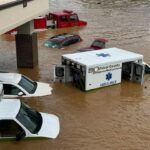
Problem: Water Shortage
Scope: Personal, Local, Regional,
Impact: Minor, Major (Depending on severity)
Dangers (not limited to): Contaminated Water Supply, Dehydration, Sickness, Crops dying
Preps (not limited to): Store drinking water in the house, collect rainwater, Water purification
Water Collection, Storage, and Purification:
Water is essential for our survival. It is crucial to have access to clean and safe drinking water, especially during emergencies when water shortages can occur. In order to be prepared for such situations, it is important to understand the causes of water shortages, the impact they can have on stores and communities, and the strategies to collect, store, and purify water at home for long-term emergency preparedness.
Causes of Water Shortages
Water shortages can arise from various factors, including natural disasters, infrastructure failures, contamination, and droughts. Natural disasters like hurricanes, floods, and earthquakes can damage water supply systems, leading to disruptions in water distribution. Infrastructure failures, such as pipe bursts or equipment malfunctions, can also result in limited access to clean water. Contamination of water sources, either due to industrial accidents or natural causes, can render water unsafe for consumption. Additionally, prolonged droughts can deplete water sources, making it difficult to meet the water demands of communities.
Impact of Water Shortages
Water shortages can have a significant impact on stores, communities, and individuals. Stores may experience a shortage of bottled water and other water-related supplies, leading to empty shelves and increased demand. In communities, limited access to clean water can affect daily activities, hygiene practices, and public health. Individuals may face difficulties in meeting their basic needs, such as cooking, cleaning, and staying hydrated. Vulnerable populations, such as the elderly, children, and those with medical conditions, are particularly at risk during water shortages.
Strategies for Water Collection, Storage, and Purification
To ensure you have an adequate supply of water during emergencies, consider the following strategies for water collection, storage, and purification:
- Calculate how much water you need: The average person needs at least one gallon of water per day for drinking, cooking, and hygiene. Plan to store at least a two-week supply of water for your family.
- Rainwater Harvesting: Install rain barrels or tanks to collect rainwater from your roof. This water can be used for non-potable purposes like gardening, cleaning, and toilet flushing.
- Emergency Water Storage: Store a sufficient amount of water for drinking, cooking, and personal hygiene. Aim for at least one gallon of water per person per day for a minimum of three days.
- Water Purification: Have water purification methods available, such as water filters, purification tablets, or boiling water. These methods can remove contaminants and make water safe for consumption.
- Water Treatment: Consider investing in a water treatment system, such as a water distiller or reverse osmosis system, to ensure a long-term supply of clean drinking water.
- Container Selection: Use food-grade containers to store water and ensure they are tightly sealed to prevent contamination. Avoid using containers that have previously held chemicals or non-food substances.
- Store water in a cool, dark place: Store water in a cool, dark place away from sunlight and heat sources. Direct sunlight and heat can cause the plastic to break down and release chemicals into the water.
- Rotation and Maintenance: Regularly rotate stored water to maintain its freshness and quality. Check containers for signs of deterioration or leakage and replace them as necessary.
- Community Water Sources: Identify nearby community water sources, such as rivers, lakes, or ponds, and learn about water treatment methods to make them safe for consumption if necessary.
By implementing these strategies, you can enhance your water preparedness and minimize the impact of water shortages during emergencies. Remember to regularly assess and update your water storage and purification methods to ensure they remain effective and reliable.
Water collection, storage, and purification are vital aspects of emergency preparedness. Understanding the causes and impacts of water shortages allows us to take proactive steps to safeguard our water supply. By following the strategies outlined above, you can ensure access to clean and safe water during times of crisis, promoting the well-being and resilience of yourself and your loved ones.
It is our mission to educate, equip, and empower everyday ordinary civilians to understand, prepare for, and survive any emergency they face. We cannot rely on the government to take care of us. We must take it upon ourselves to provide for and protect ourselves and our families.
Note: I am an affiliate with Amazon and may receive a commission from products purchased from Amazon. This helps me continue to put out emergency preparedness information for you.






